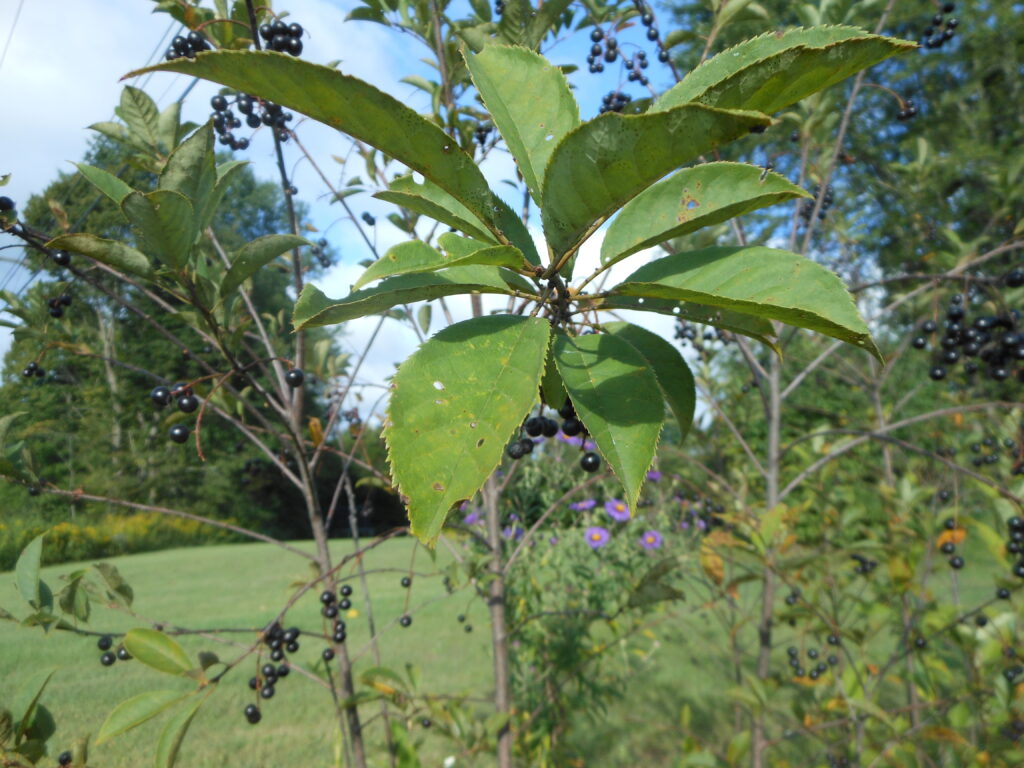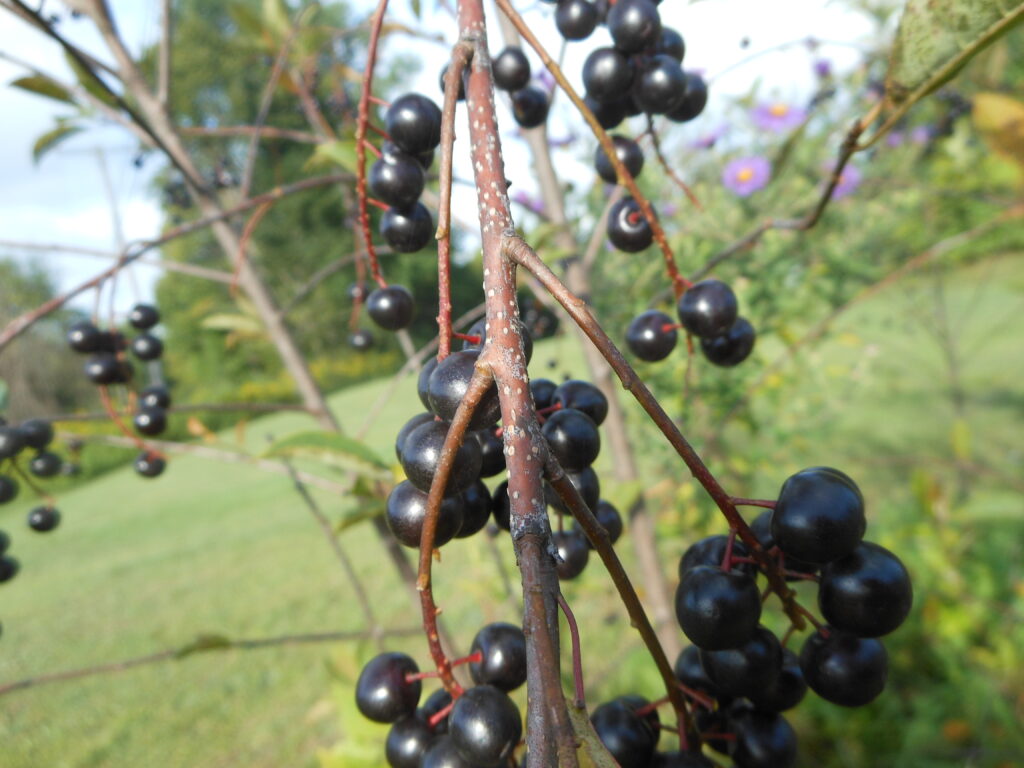Chokecherry – Prunus Virginiana
Chokecherry foraging was a staple for numerous Native American tribes across the North American continent, especially those who lived on the plains and prairies. The Cheyenne used the limbs to make arrow shafts and bows. The Crows used it for tipi stakes and pins. Early trappers washed their steel traps in water boiled with the bark to remove the scent.

In their journals, Lewis and Clark recorded that while camped on the upper Missouri River Captain Lewis became ill with abdominal cramps and fever. He made a tea from chokecherry twigs and was well the next day.
The leaves, bark, stem, and seed pit of chokecherry are all toxic due to production of hydrocyanic acid.
The leaves of the chokecherry serve as food for caterpillars and the tree can be a host for the tent caterpillar.
Description
The chokecherry may reach a height of over 30 feet. Its crown is irregular and may spread between 10 to 20 feet. The stems are numerous and slender. The chokecherry’s leaves are dark green and glossy above and paler below. They are alternate on the stem shaped oval to broadly elliptic in shape and are 1” – 4” long and ¾” – 2” wide. The leaf edges are toothed with closely-spaced sharp teeth pointing outward forming a serrated edge. They turn yellow in autumn.
The bark of young trees may vary from gray to a reddish brown. As it ages the bark turns darker, into brownish-black and becomes noticeably furrowed. The bark is distinctly marked by horizontal rows of raised air pores. With maturation the lenticels develop into shallow grooves.
It has perfect flowers which are aromatic and arranged in cylindrical racemes 3 to 6 inches long. The racemes always grow on the current year’s leafy twig growth. Individual flowers are perfect, 1/4 to 3/8 inch in diameter with 5 white petals. The flowers start appearing before the leaves are fully developed. Flowers may appear from April to July and fruits form a couple of months later.
Location: As can be seen on the map, the chokecherry is widespread across North America. Chokecherry is found in a large geographic area and it grows abundantly in many habitat types
Edible: The flesh of the fruit is edible. Also, jelly and jam can be made from the fruit. Native Americans would mash the fruits and seeds and use it to mix with meat and make pemmican.
Nutritional Value
The small berries are loaded with fiber, vitamin C, manganese, and several other vitamins and minerals. Naturally low in calories and high in anti-oxidant properties.
The berries are rich in quinic acid and work hard to prevent urinary tract infections. The berries are also rich in flavonoids, anthocyanins, and proanthocyanins that help fight against allergies and viruses.
Harvesting Chokecherries
Don’t be too anxious to harvest chokecherries, give them plenty of time to reach maturity so the flavor will be more on the sweet side and less on the tart side. Wait until late summer when the berries are at their darkest color to harvest them. When the berries start turning dark, a taste test done every couple of days will let you know when they are at their peak.
The small berries grow in clusters that hang down from a stem, so just snap off the entire stem at harvest time. The individual berries can be removed from the stems after you get the fruit home.

Rinse the berries and allow them to air dry before storing them in the refrigerator. They will keep for up to a week. To remove the seeds and extract the juice, lightly steam the berries to soften them and strain them through a colander or cheesecloth. Fruit leather is made from the berry pulp after the berries have been steamed.
Grow Your Own
Chokecherry trees can be grown from seeds or cuttings. Seeds or seedlings can be purchased from most garden supply centers, or it’s easy to harvest and plant them yourself. To harvest seeds, wait until late fall when the chokecherries are at their ripest. Remove the pulp from the seeds and allow seeds to air dry for 24 hours. Plant seeds in a shallow hole, water and add a 2-inch layer of fallen leaves on top of the soil.
If you want to save the harvested seeds from fall for planting in the spring, place the air-dried seeds in moist sand in a cool location for 60-90 days, then plant outdoors.
To grow your own chokecherry tree from a cutting, cut a length of soft wood from the tree in the summer when the plant is actively growing. Dip the cut end into rooting hormone and plant directly into outdoor soil that has been amended with compost. Keep the soil moist and the cutting will soon develop a new root system and begin to actively produce new growth.
Notes Of Interest
* Chokecherries are valuable plants for native bees. The long-lasting blooms are rich in pollen and keep bees well-fed for several months during the early summer.
* The berries can be poisonous to humans if they are consumed in large quantities.
* Chokecherries have a single seed in each berry – its poisonous look-alike, the Buckthorn, contains several small seeds inside each berry.
* The seeds and the leaves of the chokecherry shrub contain cyanide. The amount is not enough to harm a human unless ingested in large quantities.
Back to Edible Plants